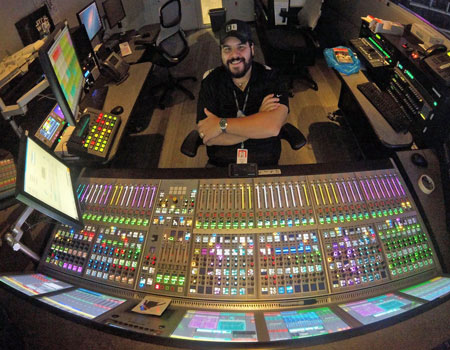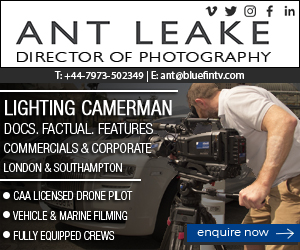Broadcast News
16/08/2019
Alex Martinez Discusses Career In Broadcast Audio Business

Sound Engineer Alex Martinez who works at Univision discusses his career in the broadcast audio business and what he thinks will be the biggest change to the way programs will be mixed over the next five years.
Tell us a little bit about who you are and what you do?
I'm the audio operator for Univision Noticias, the news wing of Univision Network, where I’ve had the privilege of working for roughly seven years. I mostly cover our live network news shows. This includes Primer Impacto, Noticiero Univision, Noticiero Univision en UniMás and Noticiero Univision Edicion Nocturna. I also work on the bigger special news events, such as US State of the Union speeches, US and Latin American election coverage and Papal visits around the globe, among many others.
How did you get into the broadcast audio business? What made you realize this was the career path you wanted to take?
I got into broadcast because of my love of audio, our fast-paced schedules and the content we cover. I love working under pressure. Whether a breaking news event across the world or a presidential election here in the States, my team always seems to really shine in these scenarios; and I’m happy to be a part of that. I also gravitated to broadcast because I wanted to mix for a larger audience. The growth potential at the network level to go from live concerts to in-studio and live broadcast is huge, you can’t get much larger than a network seen by so many in the US and simulcast to so many other countries around the world.
But my foray into audio dates back to high school, when I was working for a friend of mine who was a DJ at a local radio station. Back then, I made $50 a night, mostly lugging record crates in and out of appearances, and got to hang with them during the events. That was my first experience seeing the power that audio has over listeners’ emotions and their way of thinking. I was hooked. I wanted to learn how the recipe was put together. Soon after, I began an apprenticeship with a local club owner who, for the next decade, taught me signal flow, how to mix and even “why” circuitry behaves the way it does. Mixing live bands solidified my love for audio mixing and the technical prowess needed to do it properly. It was halfway through this apprenticeship that I decided to formally go for a second college degree, this time focused on audio.
What lead you to Univision?
It was serendipitous, really. I was working for Avid’s Pro Tools Certification School as a student advisor, and Univision called one day because they wanted to look into certifying their audio operators. However, they needed the instructor to be bilingual. The call came to me as I was the only on-site advisor who was bilingual. They invited me to their studios for a tour, and I fell in love with the fast pace and high energy on set. They just so happened to have been looking for a new audio operator, and I jumped at the opportunity.
How have you seen audio technologies, and the way sound is captured, mixed and delivered, evolve over your career? How has this changed programming or the way you work?
When I started in audio, we were still using tape- and reel-to-reel, so I think it's safe to say that audio technology has evolved tremendously. The progression from recording in analog to recording on digital and non-linear editing has been the biggest change I've seen. Everything is instantly available to mix and edit. We’re able to turn a recorded segment, edit it and send it to master within seconds. This has allowed us to now be able to update any relevant news within minutes and have it ready for the next airing on the next time zone.
On the delivery side, the current broadcast standard may no longer be accurate. The biggest change I've found is that now we’re mixing more for on-demand audiences who are tuning in on different platforms. I foresee our format changing in the next few years and adapting to this as a norm. Similar to the way in which music migrated from CD-quality to MP3 formats, so, too, will broadcast evolve in the same manner. Audio engineers will have to overcome the challenge of its viewers tuning in from home theater setups in 5.1 and mono firing speakers from a smart phone streaming live from a social media site. Automating certain tasks will also become more frequent.
What do you see as the biggest change to the way programs will be mixed in the next five years?
The biggest change is the immediacy of everything, and the quality it’s sent in. The amount of signal loss and compression that occurs when something is streamed is going to be a huge factor in the upcoming years. Everything newsworthy will be based off social media and how quickly we can come on-air to inform our audiences. I just hope we don’t lose the artform of mixing in the evolution to social media and automation. When you automate certain audio protocols, you lose that touch that makes our shows so engulfing and emotional. I can lead our audiences through the emotional highs and lows and transitions of our stories on-air and have them feel as though they watched one cohesive show – not just a bunch of random stories smashed together. This is only achieved with actual mixing within proper dynamic range.
What is the workflow that you follow?
For most shows, I sit with the director and go through the rundown he created with the rest of production. Based on the show’s needs, I’ll then go meet with our floor manager and tell him which mics and combos I need, and what the show will require for each individual segment. Everything is dictated based off how much movement we have: how many guests, translation requirements, etc. Then I work with the technical production manager to discuss the live satellite feeds. At that point, we patch the live feeds into one of our Calrec consoles and clean them up as needed so that they are broadcast-quality and level. Lastly, we establish communication with our internal studio and any necessary external sources and fold-back mixes. This would also include any mix minus needed for said show.
What Calrec consoles do you use? Are there any features that make your job easier, help you to produce a better-quality product, benefitted your workflow or increased your productivity?
Currently, I use the Calrec Artemis set up as 48-fader frame, but I actually started mixing broadcast audio on the Alpha. Univision also currently deploys the Apollo, but I prefer my beloved Artemis, and the Summa console for smaller productions.
The ease of patching and routing on the Calrec Artemis has been a game changer. The console allows me to do everything internally, and from the comfort of my mix position. It has completely eliminated the need to go to any type of patch bay, while the flexibility of internal routing saves me a lot of time. Whenever necessary, I can quickly route anything the director needs and adapt to any changes without worrying that I am sacrificing my attention to the mix.
Then, there's the most important part: the sound. As mixers, we sometimes forget how a clean signal can drastically ease our tasks. The console itself is the clearest console I’ve ever had the pleasure to work on. The noise floor is so low that it's imperceptible, thanks to the EQ and compressor. There’s no unwanted color or harmonics, it’s amazing how clean it sounds. It allows the elements to just sit in the mix and mingle with each other, instead of fighting for the audio space.
Can you think of a time when the Calrec consoles helped resolve any problems you were facing during a production?
There was a time during the 2016 US election that we had to use multiple studios, which required different control rooms. We had to unite them and work out of three studios simultaneously with continuous translation – from Spanish to English and English to Spanish – to air, throughout. At one point, I believe we had about 12 translators going simultaneously. Of course, this was in addition to our in-studio talent, guests and live feeds. The broadcast was aired live on our two networks and simulcast on social media. Due to the flexibility of the Calrec console, I was able to route all audio, mix minus and outputs (with different reference levels) without having to rely on other control rooms for additional I/O or submixing.
www.calrec.com
Tell us a little bit about who you are and what you do?
I'm the audio operator for Univision Noticias, the news wing of Univision Network, where I’ve had the privilege of working for roughly seven years. I mostly cover our live network news shows. This includes Primer Impacto, Noticiero Univision, Noticiero Univision en UniMás and Noticiero Univision Edicion Nocturna. I also work on the bigger special news events, such as US State of the Union speeches, US and Latin American election coverage and Papal visits around the globe, among many others.
How did you get into the broadcast audio business? What made you realize this was the career path you wanted to take?
I got into broadcast because of my love of audio, our fast-paced schedules and the content we cover. I love working under pressure. Whether a breaking news event across the world or a presidential election here in the States, my team always seems to really shine in these scenarios; and I’m happy to be a part of that. I also gravitated to broadcast because I wanted to mix for a larger audience. The growth potential at the network level to go from live concerts to in-studio and live broadcast is huge, you can’t get much larger than a network seen by so many in the US and simulcast to so many other countries around the world.
But my foray into audio dates back to high school, when I was working for a friend of mine who was a DJ at a local radio station. Back then, I made $50 a night, mostly lugging record crates in and out of appearances, and got to hang with them during the events. That was my first experience seeing the power that audio has over listeners’ emotions and their way of thinking. I was hooked. I wanted to learn how the recipe was put together. Soon after, I began an apprenticeship with a local club owner who, for the next decade, taught me signal flow, how to mix and even “why” circuitry behaves the way it does. Mixing live bands solidified my love for audio mixing and the technical prowess needed to do it properly. It was halfway through this apprenticeship that I decided to formally go for a second college degree, this time focused on audio.
What lead you to Univision?
It was serendipitous, really. I was working for Avid’s Pro Tools Certification School as a student advisor, and Univision called one day because they wanted to look into certifying their audio operators. However, they needed the instructor to be bilingual. The call came to me as I was the only on-site advisor who was bilingual. They invited me to their studios for a tour, and I fell in love with the fast pace and high energy on set. They just so happened to have been looking for a new audio operator, and I jumped at the opportunity.
How have you seen audio technologies, and the way sound is captured, mixed and delivered, evolve over your career? How has this changed programming or the way you work?
When I started in audio, we were still using tape- and reel-to-reel, so I think it's safe to say that audio technology has evolved tremendously. The progression from recording in analog to recording on digital and non-linear editing has been the biggest change I've seen. Everything is instantly available to mix and edit. We’re able to turn a recorded segment, edit it and send it to master within seconds. This has allowed us to now be able to update any relevant news within minutes and have it ready for the next airing on the next time zone.
On the delivery side, the current broadcast standard may no longer be accurate. The biggest change I've found is that now we’re mixing more for on-demand audiences who are tuning in on different platforms. I foresee our format changing in the next few years and adapting to this as a norm. Similar to the way in which music migrated from CD-quality to MP3 formats, so, too, will broadcast evolve in the same manner. Audio engineers will have to overcome the challenge of its viewers tuning in from home theater setups in 5.1 and mono firing speakers from a smart phone streaming live from a social media site. Automating certain tasks will also become more frequent.
What do you see as the biggest change to the way programs will be mixed in the next five years?
The biggest change is the immediacy of everything, and the quality it’s sent in. The amount of signal loss and compression that occurs when something is streamed is going to be a huge factor in the upcoming years. Everything newsworthy will be based off social media and how quickly we can come on-air to inform our audiences. I just hope we don’t lose the artform of mixing in the evolution to social media and automation. When you automate certain audio protocols, you lose that touch that makes our shows so engulfing and emotional. I can lead our audiences through the emotional highs and lows and transitions of our stories on-air and have them feel as though they watched one cohesive show – not just a bunch of random stories smashed together. This is only achieved with actual mixing within proper dynamic range.
What is the workflow that you follow?
For most shows, I sit with the director and go through the rundown he created with the rest of production. Based on the show’s needs, I’ll then go meet with our floor manager and tell him which mics and combos I need, and what the show will require for each individual segment. Everything is dictated based off how much movement we have: how many guests, translation requirements, etc. Then I work with the technical production manager to discuss the live satellite feeds. At that point, we patch the live feeds into one of our Calrec consoles and clean them up as needed so that they are broadcast-quality and level. Lastly, we establish communication with our internal studio and any necessary external sources and fold-back mixes. This would also include any mix minus needed for said show.
What Calrec consoles do you use? Are there any features that make your job easier, help you to produce a better-quality product, benefitted your workflow or increased your productivity?
Currently, I use the Calrec Artemis set up as 48-fader frame, but I actually started mixing broadcast audio on the Alpha. Univision also currently deploys the Apollo, but I prefer my beloved Artemis, and the Summa console for smaller productions.
The ease of patching and routing on the Calrec Artemis has been a game changer. The console allows me to do everything internally, and from the comfort of my mix position. It has completely eliminated the need to go to any type of patch bay, while the flexibility of internal routing saves me a lot of time. Whenever necessary, I can quickly route anything the director needs and adapt to any changes without worrying that I am sacrificing my attention to the mix.
Then, there's the most important part: the sound. As mixers, we sometimes forget how a clean signal can drastically ease our tasks. The console itself is the clearest console I’ve ever had the pleasure to work on. The noise floor is so low that it's imperceptible, thanks to the EQ and compressor. There’s no unwanted color or harmonics, it’s amazing how clean it sounds. It allows the elements to just sit in the mix and mingle with each other, instead of fighting for the audio space.
Can you think of a time when the Calrec consoles helped resolve any problems you were facing during a production?
There was a time during the 2016 US election that we had to use multiple studios, which required different control rooms. We had to unite them and work out of three studios simultaneously with continuous translation – from Spanish to English and English to Spanish – to air, throughout. At one point, I believe we had about 12 translators going simultaneously. Of course, this was in addition to our in-studio talent, guests and live feeds. The broadcast was aired live on our two networks and simulcast on social media. Due to the flexibility of the Calrec console, I was able to route all audio, mix minus and outputs (with different reference levels) without having to rely on other control rooms for additional I/O or submixing.
www.calrec.com
Top Related Stories
Click here for the latest broadcast news stories.
11/11/2016
What Is The Future For Immersive Audio?
Peter Poers, Managing Director at Jünger Audio, looks at production efforts versus consumer experience. Introduction Along with the evolution of highe
What Is The Future For Immersive Audio?
Peter Poers, Managing Director at Jünger Audio, looks at production efforts versus consumer experience. Introduction Along with the evolution of highe
26/11/2024
Ikegami Sees Accelerating Adoption of IP and Mixed-Format Broadcast Production
Ikegami has reported an accelerating migration to high-efficiency IP and mixed-format UHD/HD content creation throughout 2024. Product developments an
Ikegami Sees Accelerating Adoption of IP and Mixed-Format Broadcast Production
Ikegami has reported an accelerating migration to high-efficiency IP and mixed-format UHD/HD content creation throughout 2024. Product developments an
14/05/2012
Jünger Audio Makes Audio Loudness Its Focus At Broadcast Asia 2012
Dynamics specialist Jünger Audio will focus on controlling audio loudness in the broadcast chain at this year’s Broadcast Asia convention in Singapore
Jünger Audio Makes Audio Loudness Its Focus At Broadcast Asia 2012
Dynamics specialist Jünger Audio will focus on controlling audio loudness in the broadcast chain at this year’s Broadcast Asia convention in Singapore
08/06/2011
Jünger Audio Introduces New High Performance Audio Processing Products At Broadcast Asia 2011
Dynamics processing specialist Jünger Audio will be showing a number of new projects at Broadcast Asia 2011 (Stand: 4U3-01), including the award-winni
Jünger Audio Introduces New High Performance Audio Processing Products At Broadcast Asia 2011
Dynamics processing specialist Jünger Audio will be showing a number of new projects at Broadcast Asia 2011 (Stand: 4U3-01), including the award-winni
19/07/2024
nxtedition Unveils XR/Mixed Reality Studio Control And New AI Automation Capabilities
nxtedition will showcase its agile microservices-based approach to storytelling on stand 7.A02 at IBC2024 from 13-16 September. At IBC, visitors will
nxtedition Unveils XR/Mixed Reality Studio Control And New AI Automation Capabilities
nxtedition will showcase its agile microservices-based approach to storytelling on stand 7.A02 at IBC2024 from 13-16 September. At IBC, visitors will
19/08/2019
FOR-A Provides Mixed SDI And IP Solutions
FOR-A a provider of broadcast systems integration as well as a broad range of broadcast and ProAV products is seeing within its customer base a requir
FOR-A Provides Mixed SDI And IP Solutions
FOR-A a provider of broadcast systems integration as well as a broad range of broadcast and ProAV products is seeing within its customer base a requir
11/01/2019
Mixed Breed, Fluffy And Scruffy Dogs More Popular In TV, Film And Media
Scruffy, fluffy dogs and crossbreed dogs have never been more popular in TV, film and media and here at Urban Paws UK, we love them all! Mixed Breeds
Mixed Breed, Fluffy And Scruffy Dogs More Popular In TV, Film And Media
Scruffy, fluffy dogs and crossbreed dogs have never been more popular in TV, film and media and here at Urban Paws UK, we love them all! Mixed Breeds
15/08/2018
White Light And disguise To Introduce 'Mixed Reality Tech Lab' At IBC
White Light and disguise have collaborated to produce a fully immersive production environment, 'Mixed Reality Tech Lab', which will be revealed in th
White Light And disguise To Introduce 'Mixed Reality Tech Lab' At IBC
White Light and disguise have collaborated to produce a fully immersive production environment, 'Mixed Reality Tech Lab', which will be revealed in th
19/02/2016
Learn To Earn: Mixed Gems At BVE 2016
Tools, apps and production gurus to the fore: George Jarrett looks forward to some of the best attractions offered by BVE. Sitting so close to NAB, BV
Learn To Earn: Mixed Gems At BVE 2016
Tools, apps and production gurus to the fore: George Jarrett looks forward to some of the best attractions offered by BVE. Sitting so close to NAB, BV
26/03/2013
Hamlet's Mixed Format T&M For NAB 2013
At this year's NAB 2013 Hamlet will be showcasing a new range of instruments. The new DigiTek, DigiScope DS900G and VidScope MH2B, will be on display
Hamlet's Mixed Format T&M For NAB 2013
At this year's NAB 2013 Hamlet will be showcasing a new range of instruments. The new DigiTek, DigiScope DS900G and VidScope MH2B, will be on display
09/01/2012
War Horse Receives Mixed Reviews
It is the day after the premiere of Steven Spielberg’s latest directorial pursuit and UK critics have split opinions over the war epic. War Horse prem
War Horse Receives Mixed Reviews
It is the day after the premiere of Steven Spielberg’s latest directorial pursuit and UK critics have split opinions over the war epic. War Horse prem
29/11/2011
2012 Olympic National Anthems Mixed Using The Genelec 8240
It's possible that you haven't even heard of Recording Engineer Jake Jackson; but you'd have to be living under a rock if you hadn't heard of the proj
2012 Olympic National Anthems Mixed Using The Genelec 8240
It's possible that you haven't even heard of Recording Engineer Jake Jackson; but you'd have to be living under a rock if you hadn't heard of the proj
02/07/2010
Bravo For Mixed Martial Arts!
A long term programming commitment to Mixed Martial Arts (MMA) fighter Alex Reid following his successful inaugural documentary series for Bravo earli
Bravo For Mixed Martial Arts!
A long term programming commitment to Mixed Martial Arts (MMA) fighter Alex Reid following his successful inaugural documentary series for Bravo earli
12/01/2009
PlayBox Shows Remote Playout And Mixed Format Handling At BVE 2009
At BVE 2009, PlayBox Technology is presenting its latest playout solutions that build on its established range that already power over 6,000 channels
PlayBox Shows Remote Playout And Mixed Format Handling At BVE 2009
At BVE 2009, PlayBox Technology is presenting its latest playout solutions that build on its established range that already power over 6,000 channels
20/05/2008
Mixed Reception For New Indiana Jones Movie
The return of Indiana Jones to the big screen after an absence of nearly twenty years has been greeted by a mixed reception from film critics. 'Indian
Mixed Reception For New Indiana Jones Movie
The return of Indiana Jones to the big screen after an absence of nearly twenty years has been greeted by a mixed reception from film critics. 'Indian















